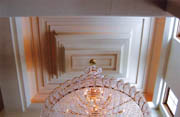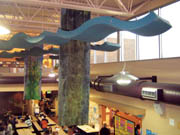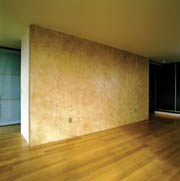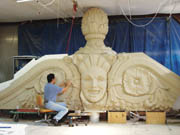We asked each company to submit a profile of the job. In their own words, they talk about the job, products used and why they thought they should win.
Congratulations to the award recipients and to all those that submitted to this contest. Please watch for next year's contest information in mid-2006.

Drywall category: South Valley Drywall Inc.
This 11,000-square foot home boasts nearly every kind of drywall detail ever installed. Every room has a unique treatment of some kind. There are no flat ceilings or boring rectangular rooms.The curved open stairwell gracefully meanders from the basement to the second floor. The dining room features a barrel ceiling with a matching oval light trough all hand bent to exacting standards. The formal living room enhances this look with a deeper barrel ceiling and a double light trough constructed from step board and Westroc cove. The kitchen features a breakfast nook that slopes inward, using more than 20 different layers of step board reaching in to create the perfect space to hold the antique lighting fixture. The two-story family room completes this theme with deep-trapped ceiling and step detailed light trough.
Upstairs, there are three bedrooms boasting similar treatments: vaults, barrels, drywall friezes and numerous step and cove details. The real treat here is the master retreat that features a multi-tiered step detail that is enhanced by three separate lighting techniques. The master bath with its oval detail that mirrors the oval tub below is simply elegant and the egg-shaped dome in its center is a testament to perfection in our craft. Surrounding this work of art is yet another multi-tiered and frieze detail that borders the room.
With all of this handcrafted beauty why should the basement be any different? The billiards area creates the perfect space with its complex combination of drywall friezes and steps. The sunken recreation room is a monument to our industry with more than 20 steps bathed softly in warm light from the embedded rope lighting.
All in all, this home feature more than one mile of step board and nearly one mile of drywall cove molding. All of the domes, traps, friezes, medallions and step details in this home were hand crafted. Nothing in this home was prefabricated, everything was designed, framed and drywalled in the field using the materials listed. This home is a testament to American craftsmanship and imagination.
- Roger Barrett,
South Valley Drywall Inc.,
Littleton, Colo.
Materials used:
• Drywall: National Gypsum 1/2- and 5/8-inch board; 945 4-foot-by-8-foot sheets
• Bullnose and metal trims: Award Metals
• Step board, drywall cove and cornice: Westroc
• Joint compound and texture: Murco Wall Products
• Paper-face trim: USG Corp.
Other details:
• Builder: Celebrity Builders
• Architect: Everett Verdoorn
• Budget: $75,000
• Cost: $77,939 with change orders
• Total man-hours: 856

Ceilings category: Heartland Acoustics and Interiors Inc.
Christiansen Reese Partners Architects and Nunn Construction made up the construction team for the Da Vinci Academy, located in Colorado Springs, Colo. The project included more than 20,000 square feet of acoustical ceilings, 1,500 square feet of acoustical wall panels, 152 metal ceiling waves and boxes, 50 hanging ceiling baffles, 40 pyramidal diffusers and six radius metal light coves.The project had extensive customized fabrications for the metal ceilings and extremely intricate layouts. Virtually every portion of the project had individual layouts for each product installed. This required extensive design development in the preconstruction phases to achieve the intended design and still main cost effectiveness.
The original design for the floating metal waves consisted of one piece of metal that had to be bent and shaped to form a box. After much research, it was realized it would be more effective to create the waves by making individual parts of the wave and welding the components together. The side rails were cut to the intended shape and welded to the bottom piece to form the complete unit. After each wave was created off site and field painted, the waves were laid out on an angle that was different from the layout of any other joist, wall, rail or other part of the building structure. Control lines had to be set in numerous directions for every wave in order to maintain the consistency of the design and vision. The placements of the hanger wires were difficult due to roof joists, ducts, lights, piping and other components of the building that obstructed vertical placement of the hanger wires.
A large number of man-hours were spent to reach the goal of the architect, owner and general contractor. This same scenario holds true for the Tectum baffles and the Wenger pyramidal diffusers. Once again, numerous control lines had to be used in order to create the pattern and functionality of the design and maintain acoustical performance.
The project took a large amount of management and field supervision to ensure that all of the custom work was done correctly. With almost four months on site and change orders totaling 13 percent of our contract, we were still able to bring this project in on budget and on schedule. We are very proud of our work on this project.
- Jason Gordon,
Heartland Acoustics and Interiors,
Englewood, Colo.
Materials used:
• Acoustical ceilings: USG Interiors' Donn DX-24 Grid System, Aspen Ceiling Tile, Radar Ceramic Ceiling Tile, Radar Clima Plus Ceiling Tile
• Specialty metal ceilings: Custom fabricated metal waves and boxes, Gordon Inc.'s Light Coves
• Fabric-wrapped acoustical panels: Lamvin Inc.
• Pyramidal diffusers: Wenger Corp.
• Hanging baffles: Tectum
Other details:
• Architect: Christiansen Reese Partners
• General Contractor: Nunn Construction
• Acoustical distributor: Western Interior Supply
• Metal fabricator: Diamond Perforated Metals
• Scissor lift rentals: Ahern Rentals

Ornamental/plastering category: Buon Fresco
Richard Williams Architects, of Washington D.C., approached Buon Fresco about a very special project that they were working on in the District of Columbia. The architectural firm had been contracted to take three apartments in a luxury building on the Potomac River and combine them, creating a large, airy, contemporary city space for a large family's sizeable pied a terre for their city home. The clients wanted a special feeling for the space of contemporary simplicity yet where bold strokes of color and design would provide a foil for an abundant art collection, as well as the eclectic backdrop for their busy lifestyles. This was to be no run-of-the-mill design challenge.Over the course of several meetings between the architects, the lady-to-be-of-the-manor, as well as Buon Fresco's artistic director and color expert Victoria Bingham, chose to design colorful focal point walls that would stand out from a vast panorama of off-white and gray. Bingham began to custom mix and match paint colors by collecting fabric samples from the homeowner and matching them-in turn-a gorgeous orange (custom mixed in Italian plaster); linen whites for the vast wall spaces in corridors and bedrooms (matched to Benjamin Moore White #953 and OC-29); and finally a striking assortment of custom-mixed grays for the different levels of drop ceilings. The color combinations already set the stage for the contemporary tone to be achieved.
As it played out, the long walls of the apartment's wide corridors were made quietly present in a matte painting of linen white, complemented by drop ceilings painted a warm gray below a ceiling line of a charcoal gray, which resounded heartily juxtaposed next to the flat columns covered floor to ceiling in the classy burnt-orange, custom-mixed Italian plaster.
The bold "focal strokes" were saved for select bedroom walls and the entry foyer. The four bedrooms were painted with Benjamin Moore floral white in a matte sheen, then treated to one focal wall of strong color and finish, each room with a distinctly different feeling:
• One daughter's bedroom received a flashy red Merimekko-style floral wall painted in five different bold red colors, four different sheens, in both oil- and water-based paint, finished with touches of the floral white from the surrounding walls.
• A second daughter's bedroom had two focal walls fabulously finished with a polished rose-colored Italian plaster over which a matte Italian plaster damask design was applied. The reversal of sheens affect a genuine damask fabric light-play on the walls.
• The third daughter's bedroom had the doorframe wall enhanced with, in this case, a yellow matte finish Italian plaster over which a high-polished floral design was applied, giving the walls the reverse light effect of the neighboring pink room.
• The architects' design for the master bedroom included a focal wall set apart from the room's perimeter. For this wall's contemporary accent, Bingham applied a custom recipe for 11 coats of paints and varnishes, to create a faux leather remarkably realistic in both look and feel.
• The most visible wall in the house was to be that in the foyer directly next to the front door. The floor in the foyer is concrete and the drop ceiling a block of rich mahogany. So for this contemporary wall statement, Bingham designed a four-color Italian plaster of glassy grays over a rich brown, pulling the local elements and colors together in this first impression of the home.
Overall, 15 focal point walls were finished in the completed home. The project, between painting the walls, ceilings and trim and applying the Italian finishes, took the entire month of January 2005. The apartment was displayed on the Washington D.C. Corcoran Awards, for Decoratively Painted and Plastered works.
From a design standpoint, the project of creating an artistic, livable, colorful and contemporary space as requested, was a complete success.
- Victoria Bingham,
Artistic Director,
Buon Fresco,
Alexandria, Va.
Materials used:
• Plasters: Lithos Venetian Plaster, manufactured by Lafarge Coatings of Italy; Kolcaustico Venetian Plaster, manufactured by Sepp Leaf Products
• Tints: Mixol Tints, from Mixol Co. in Germany (imported by Sepp Leaf)
• Paints: Benjamin Moore fine paints
• Varnishes: Benjamin Moore Latex Varnish; Pratt & Lambert Oil Varnish

EIFS/stucco category: Buffalo Plastering
In 1926, construction of Shea's Buffalo Performing Arts Theater began and only took one year to complete. It was built on Main Street in the heart of downtown Buffalo, N.Y. Shea's-when first constructed-was one of the most elaborate theaters produced and regarded as one of the finest intact movie palaces in the country. Its architectural style is French Renaissance in the Louis XIV with American adaptation.Within seven years after it was built, the ornate terra cotta façade was showing signs of failing and the structural integrity was lacking. The upper most ornate part of the pediment had to be removed and Shea's exterior remained incomplete for almost eight decades until its recent restoration.
Buffalo Plastering was honored to be chosen for the restoration and replication of the historic building. Owner Gary Bolles and Leo Lysy of the company located photos at the local historical museum. Although there were only a few photos to show what Shea's original exterior looked like, the company took on the job relying on the skills of its sculptor and of the quality of its team. Those photos and what remained of the building directed the team on what had to be made to match the original.
The nine-month project started with sculptors Leo Lysy and Alex Tsalihkin. They first began sculpting out of plasticine (an oil-based clay). Tolerances were checked and rechecked, and rubber molds of the upper and lower pediments and the partial existing frieze were made. The finished product was cast in GFRC; this was mixed with masonry dies to match the color and mottled of the original terra cotta. A steel frame was incorporated into the panelized sculpture. The main frame was fabricated on the building, to which the panels were welded. In five days, panels were boomed into place and this restored the façade to its original design.
A slideshow of this project can be viewed on the company's site www.buffaloplastering.com.
Buffalo Plastering has been in business for 15 years. Gary Bolles and Leo Lysy have a spin-off company called Buffalo Architectural Casting.
- Gary Bolles,
Owner,
Buffalo Plastering,
Buffalo, N.Y.
Materials used:
• Glass fiber reinforced cement was mixed by Buffalo Plastering
• Polymers supplied by Ball Consulting Ltd.
• Steel framing manufactured by Marino\Ware
• Urethane molds by Polytech
• Masonry pigments from Davis Color

Report Abusive Comment